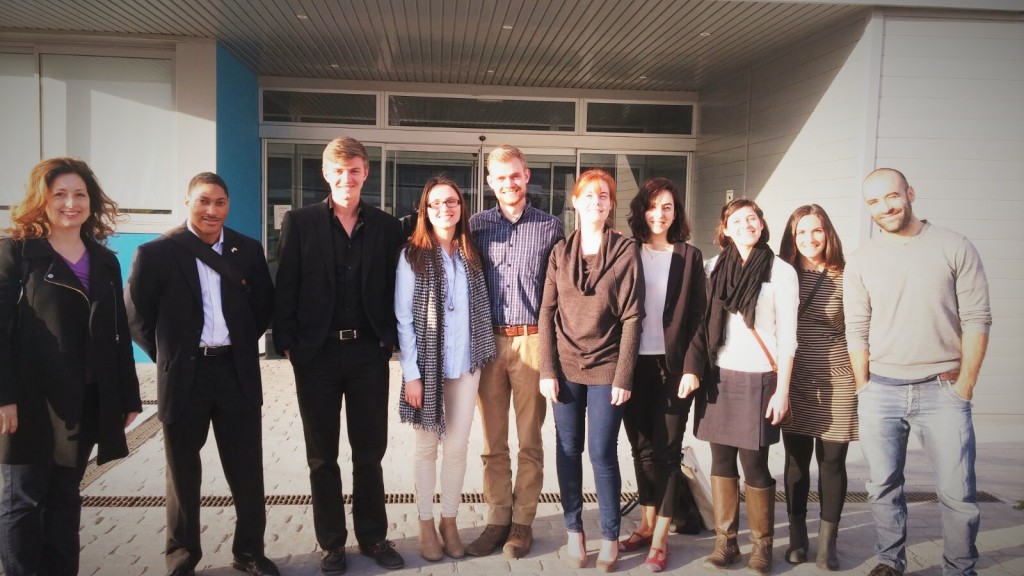 On 15 March, we commenced the IV Programa de Visitas with a visit to the Centro de Investigaciones Biológicas (CIB). The prevalence and centrality of the CIB’s resources (ie. NMR, electron microscopes) was a noteworthy aspect of this lab. The fact that the CIB has its own molecular sequencing and pharmacolgy departments was particulary interesting.
On 15 March, we commenced the IV Programa de Visitas with a visit to the Centro de Investigaciones Biológicas (CIB). The prevalence and centrality of the CIB’s resources (ie. NMR, electron microscopes) was a noteworthy aspect of this lab. The fact that the CIB has its own molecular sequencing and pharmacolgy departments was particulary interesting.
Following the visit to the CIB, we conducted a tour of the Centro de Investigaciones Energéticas, Medioambientales y Tecnológicas (CIEMAT). While some students toured the particle physics setion of the facility, others toured the section dedicated to biomedical research, particularly for rare diseases. The facility’s fine-tuned organization, sterility protocols, and use of renewable energy and sustainable resources made it a major hit amongst the grantees.
We wrapped up the day with a visit to the Instituto de Investigación en Ciencias de la Alimentación (CIAL). The CIAL provided us with great insight into not only how food is prepared and processed, but how different compounds in food might be investigated for health applications. After visiting a few of the smaller labs, we saw the larger machines, where biochemical compounds were extracted and refined from plant products. This visit certainly seemed to pique grantees’ interests in how food is prepared and how its different components could be applied in ways previously unknown.
On 16 May, our tours recommenced with a visit to the Instituto de Química Médica (IQM). The IQM meeting afforded us an examination of how the active components of medicines are prepared and modified. The presentations highlighting the application of this information towards disease treatment were especally informative. They emphasized not only the end-goal of such research but also the extensive process needed to arrive there, and I believe this provided us with a greater appreciation for the fine-tuned, molecular details that can make all the difference in disease treatment.
After the IQM visit, we met with representatives of the Fundación Ramón Areces, a private foundation with particular investment in rare disease research. The meeting provided an interesting view into the involvement of a private entity in scientific research—a unique perspective, since a great deal of the research conducted in Spain is backed by the government.
We finalized our tours with a visit to PharmaMar a pharmacology company based on the premise of discovering medical resources from marine life, particularly for battling various types of cancer. The meeting afforded us an engaging and novel perspective on how pharmacologics could be attained from marine resources. I believe this visit granted us greater depth regarding the drug development process, particularly with the investment of time and capital into research. It also seemed to spark discussions on the pursuit of novel resources for furthering medical development, as well as ecological conservation and sustainability.
Overall the IV Programa de Visitas seemed to be highly beneficial. The participants not only enjoyed the opportunity to learn more about Spain’s involvement in research, but also to discuss this information with one another and share their own experiences in research. On a personal note, I feel this experience exposed me to career paths and connections I was not cognizant of before. Though I still remain committed towards a career in medicine, the program showed me numerous novel applications in how I might use the skills I attain in patient care and clinical investigation. As a whole, the program will certainly give us several options and opportunities to consider as we progress in our respective careers.
Finally, I would like to thank the Fundación Consejo España-EEUU and Fulbright Spain for organizing and making all these visits possible.
James A. Knight
2015 Fulbright grantee at Instituto Cajal/CSIC